Topology optimization
For Airbus (Toulouse, France), topology optimization is just one of many computer-aided optimization techniques that have been employed in the aircraft design process — and employed ever earlier — to reduce time and cost.
As one of the pioneers in the use of topology optimization in aircraft design, Toulouse, France-based Airbus used OptiStruct software by Altair Engineering (Troy, Mich.) for design optimization on the A350 XWB to support weight reduction, including the fuselage tail (Section 19), wingbox and wing flap support structure. Common results include 30 percent weight reduction, 30 percent improved performance (e.g., stiffness, strength) and 50 percent cost savings. A-E-S Europe GmbH (Hanover, Germany), a computer-aided engineering (CAE) firm that specializes in simulation and structural optimization, describes topology optimization as a finite element analysis (FEA) algorithm that evolves the optimal lightweight shape for a structural design, similar to what nature does in bones, trees, and bird wings, for example, but in a week vs. hundreds of years. The company’s Web site gives the example of a 5-MW wind turbine for which the manufacturer needed to significantly reduce, within a tight time line, both bedplate and gearbox mass without increasing structural stress or reducing stiffness. A-E-S Europe used topology optimization to derive a completely new shape within one week. The result cut the mass of the two components by 35 percent without increasing the maximum stresses. This was accomplished by removing dead mass (mass where it does not support functionality), adding mass to the structure along key load paths and realizing a homogeneous stress distribution, that is, stress distributed uniformly throughout the structure without peak stress points.
For Airbus, topology optimization is just one of many computer-aided optimization techniques that have been employed in the aircraft design process — and employed ever earlier — to reduce time and cost. In fact, these techniques have become absolutely necessary to successfully optimize the increasingly large and complex composite structures of modern aircraft. For example, one of the optimization models for the A350 wingbox had to consider up to 3,000 different design variables, including ply thicknesses, fiber orientations and stringer cross-sections, as well as 300,000 constraints, such as skin buckling, column buckling, material strength and manufacturing parameters. Sizing optimization for the A350 composite forward fuselage required that Airbus engineers address 14,000 design variables (e.g., skin layup, stringer geometry and layup, etc.) and more than 1 million constraints. This forced the team to break the structural optimization model down into smaller components to reduce the variables and, thus, successfully size the components for initial design.
Related Content
-
Drag-based wind turbine design for higher energy capture
Claiming significantly higher power generation capacity than traditional blades, Xenecore aims to scale up its current monocoque, fan-shaped wind blades, made via compression molded carbon fiber/epoxy with I-beam ribs and microsphere structural foam.
-
Recycling end-of-life composite parts: New methods, markets
From infrastructure solutions to consumer products, Polish recycler Anmet and Netherlands-based researchers are developing new methods for repurposing wind turbine blades and other composite parts.
-
Composites end markets: Batteries and fuel cells (2024)
As the number of battery and fuel cell electric vehicles (EVs) grows, so do the opportunities for composites in battery enclosures and components for fuel cells.












